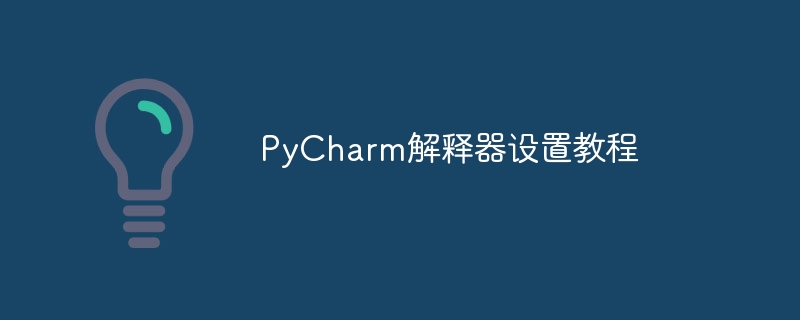Home >Backend Development >Python Tutorial >Learn how to configure PyCharm's interpreter
Learn how to configure PyCharm's interpreter
- 王林Original
- 2024-02-02 18:37:061698browse

PyCharm interpreter setting tutorial: step-by-step configuration of the Python interpreter, with detailed code examples
Introduction:
PyCharm is a powerful Python integrated development Environment (IDE), which helps Python developers write, debug and run code efficiently. When developing with PyCharm, it is very important to configure the interpreter correctly because it determines the Python environment used by the code when running. This article will introduce step by step how to set up the interpreter in PyCharm and provide specific code examples.
Step 1: Open the project
First, open PyCharm and select the project where you want to configure the interpreter. If you don't have a project yet, you can create a new project via the "New Project" option.
Step 2: Click "File" - "Settings"
In the top menu bar of the PyCharm interface, find the "File" option and click it, and select "Settings" in the drop-down menu.
Step 3: Select "Project Interpreter"
In the pop-up "Settings" window, find the "Project Interpreter" option in the left menu bar and click to select.
Step 4: Click "Add"
In the "Project Interpreter" window on the right, find and click the "Add" icon below. This will open the interpreter configuration window.
Step 5: Select the interpreter type
In the interpreter configuration window, we can select the type of interpreter. PyCharm supports local interpreters, remote interpreters and Docker container interpreters. Choose the appropriate type according to the actual situation.
Step 6: Configure the interpreter path
In the interpreter configuration window, find and click the drop-down menu button behind the "Interpreter" field and select the interpreter path to be configured. If you have not installed the Python interpreter, you can select and download the required interpreter version by clicking the "Show All..." link.
Step 7: Click "OK"
In the interpreter configuration window, click the "OK" button to save the configuration and close the window.
Code example one: Configure the interpreter path using the local interpreter
The following is an example showing how to configure the interpreter path using the local interpreter:
1. 打开PyCharm并打开项目。 2. 点击“File”——“Settings”。 3. 在“Settings”窗口中选择“Project Interpreter”。 4. 点击“Add”图标。 5. 在解释器配置窗口中选择“Local”。 6. 点击“Interpreter”字段后面的下拉菜单按钮。 7. 选择本地已安装的Python解释器路径。 8. 点击“OK”保存配置并关闭窗口。
Code example two: Use Remote interpreter configuration interpreter path
The following is an example showing how to use the remote interpreter to configure the interpreter path:
1. 打开PyCharm并打开项目。 2. 点击“File”——“Settings”。 3. 在“Settings”窗口中选择“Project Interpreter”。 4. 点击“Add”图标。 5. 在解释器配置窗口中选择“SSH Interpreter”。 6. 输入远程主机的IP地址、端口号以及SSH认证信息。 7. 点击“Test Connection”按钮,测试连接是否成功。 8. 点击“OK”保存配置并关闭窗口。
Code example three: Configure the interpreter path using the Docker container interpreter
The following is an example showing how to configure the interpreter path using the Docker container interpreter:
1. 打开PyCharm并打开项目。 2. 点击“File”——“Settings”。 3. 在“Settings”窗口中选择“Project Interpreter”。 4. 点击“Add”图标。 5. 在解释器配置窗口中选择“Docker”。 6. 输入Docker容器的名称或ID。 7. 点击“OK”保存配置并关闭窗口。
Conclusion:
Through the above steps, we can correctly configure the interpreter in PyCharm and pass the specific code Examples to aid understanding. Properly configuring the interpreter can help us better develop, debug and run Python code and improve work efficiency. I hope this article will be helpful to beginners and developers using PyCharm. For more PyCharm usage tips, please consult the official documentation or search for relevant information.
The above is the detailed content of Learn how to configure PyCharm's interpreter. For more information, please follow other related articles on the PHP Chinese website!

